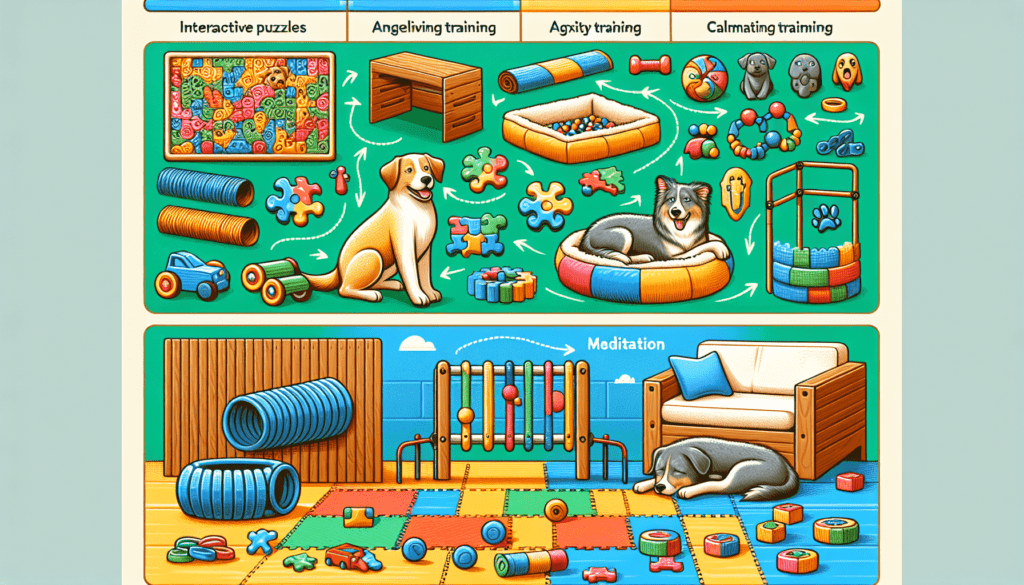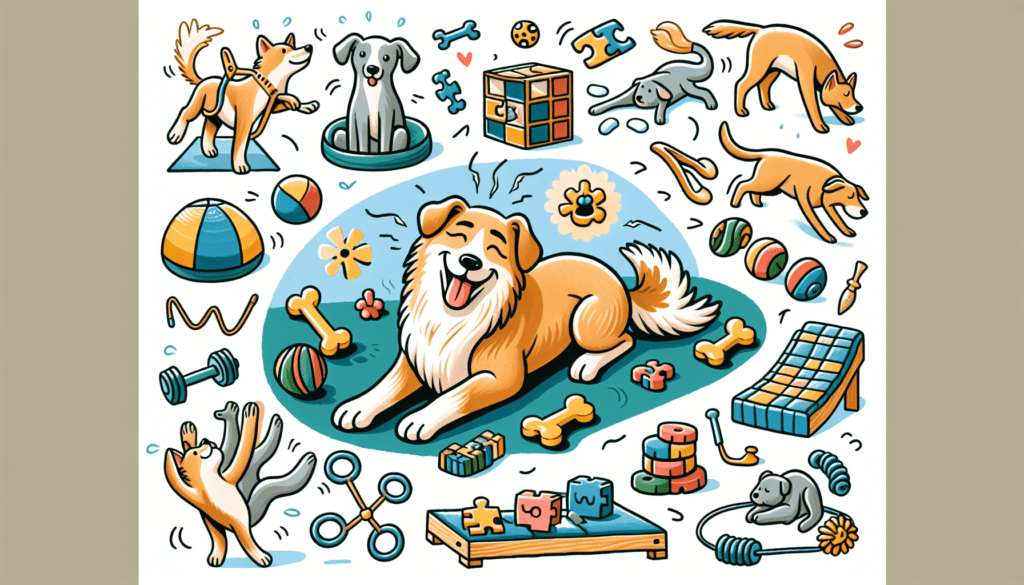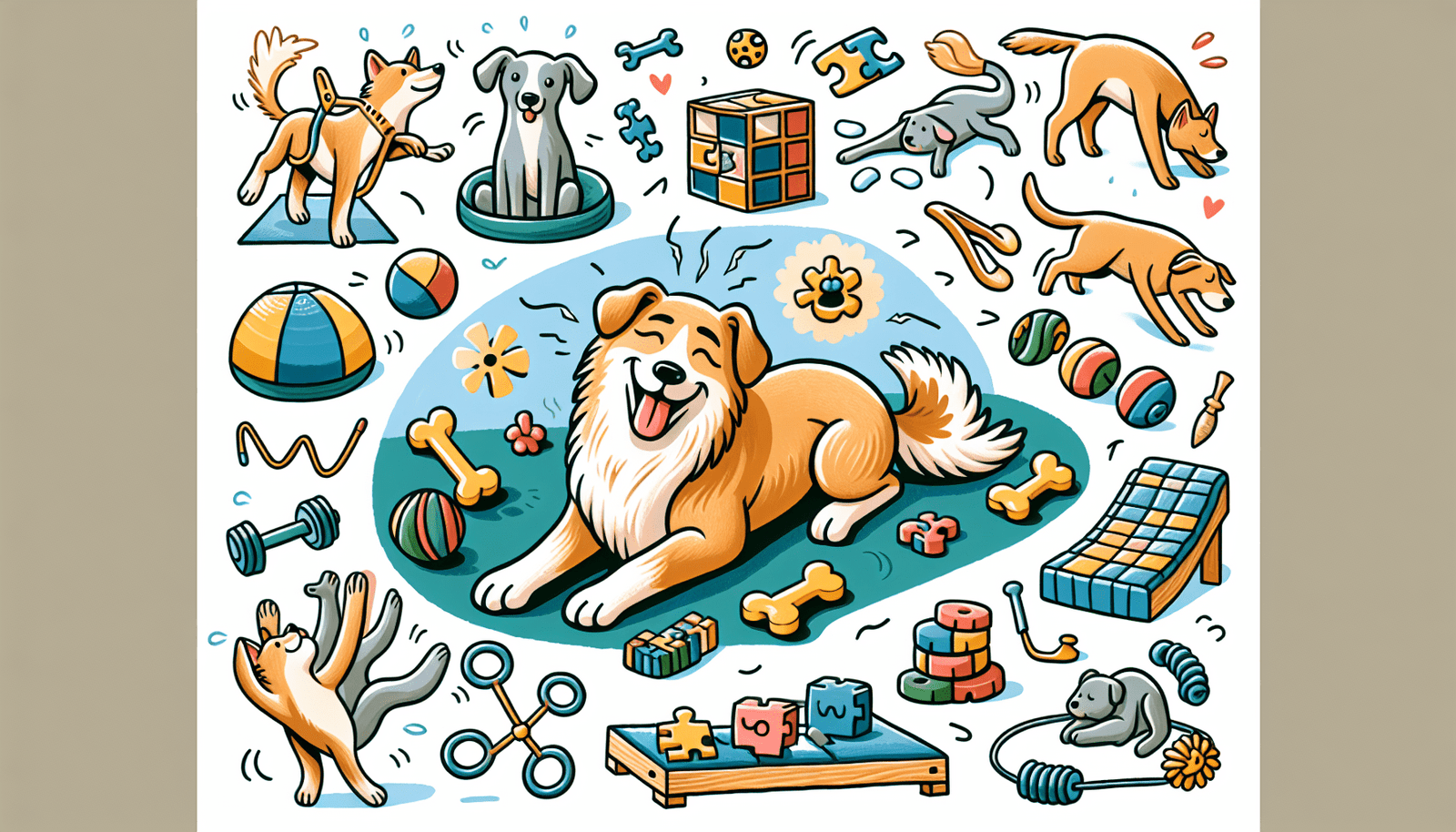Are you struggling to find ways to calm down your anxious dog? You’re not alone. Many dog owners face the challenge of finding activities that can help tire out their furry friends and alleviate their anxiety. But fret not! In this article, we will explore various exercises and games that are specifically designed to tire out anxious dogs, providing them with much-needed mental and physical stimulation. So, get ready to discover some fun and effective ways to keep your anxious pup happy and content.

Mental Stimulation Exercises
Puzzle Toys
Puzzle toys are a great way to provide mental stimulation for your anxious dog. These toys are designed to challenge your dog’s problem-solving skills and keep them engaged for extended periods of time. They often involve hiding treats or small toys inside compartments or drawers that your dog has to figure out how to open. By encouraging your dog to use their brain and think through the puzzle, these toys can help redirect their anxious energy into a focused and positive activity.
Hide and Seek
Playing hide and seek with your anxious dog is not only a fun game but also a great mental stimulation exercise. Start by having your dog sit and stay while you go hide somewhere in the house or yard. Then call out their name and encourage them to find you. As your dog searches for you, their mind will be engaged in problem-solving and using their senses to locate your hiding spot. This game can help build your dog’s confidence and reduce their anxiety by focusing their attention on a fun and rewarding activity.
Training Games
Engaging in training games with your anxious dog can provide mental stimulation while improving their obedience and focus. Teach your dog new tricks or review basic commands like sit, stay, and down. Use positive reinforcement techniques, such as treats or praise, to reward your dog for correctly performing the desired behaviors. Training games not only stimulate your dog’s mind but also strengthen the bond between you and your furry friend. This positive interaction can help reduce anxiety by promoting feelings of security and trust.
Physical Exercise Activities
Long Walks
Taking your anxious dog on long walks is a simple yet effective way to provide physical exercise and mental stimulation. The sights, sounds, and smells of the outdoors can help distract your dog from their anxious thoughts and redirect their focus on the environment. Make sure to vary your walking routes to keep your dog engaged and interested in their surroundings. Additionally, regular walks can help burn off excess energy, which can contribute to a more relaxed and calmer demeanor.
Fetch
Playing fetch is a classic and engaging physical exercise activity for dogs. Fetch not only allows your anxious dog to burn off energy but also stimulates their mind by encouraging them to chase and retrieve a toy. Start by tossing a ball or a favorite toy and encourage your dog to bring it back to you. Repeat this activity several times to keep your dog actively moving and engaged. The repetitive nature of fetch can help alleviate anxiety by providing a structured and predictable activity for your dog.
Tug of War
Tug of war is a game that can provide both physical exercise and mental stimulation for your anxious dog. The game involves you and your dog tugging on opposite ends of a rope or toy. However, it is important to establish some ground rules to ensure the game remains safe and controlled. Teach your dog the “drop it” command to avoid any potential issues with possessiveness. Tug of war can be an effective outlet for your dog’s pent-up energy and can provide a sense of accomplishment and satisfaction, which can help alleviate anxiety.
Structured Playtime
Agility Training
Agility training is a structured play activity that combines physical exercise and mental stimulation. It involves navigating an obstacle course consisting of jumps, tunnels, and weave poles. Agility training not only provides a great form of exercise for your anxious dog but also helps build their confidence and focus. Working together as a team, you can guide your dog through the course, rewarding them for successfully completing each obstacle. This structured playtime can help your dog develop better problem-solving skills and overcome their anxiety through positive reinforcement.
Flyball
Flyball is an exciting and high-energy sport that can engage both your dog’s body and mind. It involves a relay race where dogs race over a series of hurdles, trigger a box to release a tennis ball, and then return to their handler with the ball. This game provides physical exercise through running and jumping, while also stimulating your dog’s mind as they learn to focus on the task at hand. Participating in flyball can help boost your anxious dog’s confidence and provide an outlet for their anxiety by diverting their energy into a productive and structured activity.
Disc Dog
Disc dog, also known as canine disc freestyle or frisbee dog, is a fun and interactive playtime activity for both you and your anxious dog. It involves throwing a disc or frisbee for your dog to catch and retrieve. Disc dog combines physical exercise with mental stimulation as your dog learns to track and catch the disc mid-air. This activity can help improve your dog’s focus, coordination, and agility, while also providing a fun and rewarding experience. Playing disc dog with your anxious dog can help reduce their anxiety by promoting a positive and active lifestyle.
Interactive Toys
Treat Dispensing Toys
Treat dispensing toys are an excellent way to provide mental stimulation for your anxious dog while also rewarding them with tasty treats. These toys are designed to hold small treats or kibble and release them when your dog interacts with the toy in a specific way. By engaging in play and problem-solving, your dog will be challenged to figure out how to get the treats out. This type of interactive toy can keep your dog entertained for extended periods, reducing their anxiety by redirecting their focus and encouraging them to use their problem-solving skills.
Interactive Ball Launchers
Interactive ball launchers are a great interactive toy for dogs that love to chase and retrieve balls. These toys automatically launch the ball, allowing your dog to engage in a game of fetch on their own. This not only provides physical exercise but also stimulates their mind as they anticipate and chase after the ball. Some interactive ball launchers even have adjustable settings, allowing you to control the distance and direction of the launch, making the game more challenging and engaging for your anxious dog.
Squeaky Plush Toys
Squeaky plush toys can provide both mental and physical stimulation for your anxious dog. The squeaking sound can capture your dog’s attention and spark their curiosity. These toys often come in different shapes and sizes, making them great for interactive play. You can engage in a game of tug of war or toss the toy to encourage your dog to chase and retrieve it. Squeaky plush toys can help reduce anxiety by providing a playful and stimulating outlet for your dog’s unused energy, while also offering a comfort object for them to manipulate and interact with.

Relaxation Techniques
Massage
Massage is a relaxing technique that can help calm your anxious dog and promote a sense of relaxation. Gently stroke and massage your dog’s body, focusing on areas where they hold tension, such as the neck, shoulders, and back. Use slow and gentle movements, applying slight pressure to help relieve any muscle stiffness or discomfort. Massage not only helps relax your dog physically but also promotes bonding and trust between you and your furry friend. Incorporating regular massage sessions into your dog’s routine can help reduce anxiety and create a peaceful environment for them.
Slow Feeding Bowls
Slow feeding bowls are designed to slow down your dog’s eating pace and prevent them from gobbling their food too quickly. These bowls often have grooves or obstacles inside, requiring your dog to work a bit harder to access their food. By making mealtime more challenging, slow feeding bowls provide mental stimulation for your anxious dog. This can help redirect their focus from anxious thoughts to the task of eating. Slower eating also aids in digestion and can prevent issues like bloating or vomiting, which can cause additional stress and discomfort.
Calming Music
Calming music specifically designed for dogs can be a helpful tool to relax and soothe your anxious canine companion. The right type of music can have a calming effect on dogs, reducing anxiety and promoting a sense of tranquility. Look for instrumental tracks or compositions that feature classical or reggae music, as these genres tend to have a relaxing impact on dogs. Play the music at a moderate volume in a quiet and comfortable environment. Combining calming music with other relaxation techniques, such as massage or slow feeding, can create a serene atmosphere that helps your dog unwind and find inner peace.
Outdoor Adventures
Swimming
Swimming is a fantastic outdoor activity that provides both physical exercise and mental stimulation for anxious dogs. Whether it’s in a pool, lake, or the ocean, swimming engages your dog’s entire body while being gentle on their joints. It can help release pent-up energy, promote muscle tone, and improve cardiovascular health. Additionally, swimming can help alleviate anxiety by providing a soothing and calming sensation for your dog. The buoyancy of the water can create a weightless feeling, reducing stress and promoting relaxation.
Hiking
Exploring nature through hiking can be an excellent adventure for anxious dogs. Hiking not only provides physical exercise but also exposes your dog to new sights, smells, and sounds, offering a sensory experience that can help distract from anxious thoughts. Choose trails suitable for your dog’s fitness level and gradually increase the intensity and duration of your hikes over time. Incorporate training games and obedience exercises during your hikes to keep your dog mentally engaged. The combination of physical exertion and mental stimulation can help reduce anxiety and create a positive association with outdoor activities.
Frisbee
Playing frisbee with your anxious dog is a thrilling outdoor activity that combines physical exercise and mental stimulation. The game involves throwing a frisbee for your dog to catch in mid-air. The fast-paced nature of frisbee can help burn off excess energy and provide an outlet for your dog’s instinctual desire to chase and retrieve. Additionally, frisbee requires focus and coordination, challenging your dog’s mental capabilities. The sense of achievement from catching the frisbee can boost your dog’s confidence and help alleviate anxiety by providing a sense of accomplishment and fulfillment.
Scent Work
Nose Games
Nose games are a fantastic way to engage your anxious dog’s sense of smell and provide mental stimulation. These games involve hiding treats or toys and encouraging your dog to use their nose to find them. Start by placing a treat in an easy-to-find location and provide a verbal cue, such as “find it” or “search.” As your dog becomes more confident, increase the difficulty by hiding treats in harder-to-reach places or by using scent-specific games where your dog has to identify and locate a specific scent. Nose games tap into your dog’s natural instincts and provide a rewarding and captivating activity that can help reduce anxiety.
Tracking
Tracking is an activity that harnesses your dog’s scenting abilities and stimulates their mind in a controlled and structured way. It involves creating a scent trail for your dog to follow. Start by dabbing a cloth or an item with a specific scent, then lay a track by placing the scented item on the ground and walking away. Encourage your dog to follow the scent trail by giving them a verbal cue, such as “find it.” Tracking exercises your dog’s cognitive abilities, as they have to focus on following the scent and deciphering the intended path. Engaging in tracking activities with your anxious dog can help redirect their anxious energy into a productive and rewarding activity.
Scent Detection
Scent detection is an activity that taps into your dog’s incredible sense of smell and can provide mental stimulation that tires out an anxious dog. It involves teaching your dog to detect and identify specific scents, such as essential oils or certain odors. Start by introducing your dog to the target scent and rewarding them for showing interest in it. Gradually increase the difficulty by hiding the scent in different locations or containers. As your dog becomes more proficient, you can use multiple scents or create more complex searching scenarios. Scent detection exercises not only engage your dog’s mind but also provide a sense of purpose and accomplishment, leading to reduced anxiety.
Obedience Training
Sit and Stay
Basic obedience training exercises like sit and stay are essential for providing structure and discipline for your anxious dog. Teaching your dog to sit and stay on command helps establish boundaries and can redirect their anxious energy towards obedience tasks. Start by using treats or positive reinforcement to reward your dog for correctly following the commands. Gradually reduce the need for treats by transitioning to verbal and physical praise. Consistent practice of sit and stay commands can enhance your dog’s focus and impulse control, leading to a calmer and more relaxed state of mind.
Recall Training
Recall training, also known as coming when called, is an important obedience exercise that can help reinforce your dog’s bond with you and provide mental stimulation. It involves teaching your dog to respond promptly when called, even in distracting or anxiety-provoking situations. Start in a controlled and safe environment and gradually increase the challenge by adding distractions or distance. Use high-value rewards, such as treats or toys, to motivate your dog to come to you. Recall training not only reinforces your dog’s obedience but also equips them with the skills to navigate potentially stressful situations, reducing anxiety.
Downward Dog
Incorporating a yoga-inspired exercise like downward dog into your dog’s obedience training routine can provide physical exercise and mental stimulation. This pose helps stretch and lengthen your dog’s spine while engaging their core muscles. Start by having your dog sit, then gradually guide their front paws forward while keeping their back end elevated. You can use treats or praise to reward your dog for holding the pose. Downward dog can promote relaxation and help alleviate anxiety by encouraging deep belly breaths, which activate the parasympathetic nervous system, responsible for the body’s rest and relaxation response.
Socialization Opportunities
Doggy Daycare
Doggy daycare can be a valuable socialization opportunity for anxious dogs. It provides a controlled environment where dogs can interact and play with other dogs under the supervision of trained staff. Regular attendance at doggy daycare sessions can help your anxious dog build confidence, improve social skills, and reduce anxiety in the presence of other dogs. Additionally, daycare provides an outlet for physical exercise and mental stimulation, as dogs engage in play and socialization activities throughout the day.
Group Walks
Group walks offer your anxious dog the chance to socialize and interact with other dogs in a controlled setting. Walking in a group can be an excellent opportunity to expose your dog to different breeds and personalities, promoting confidence and reducing anxiety. Group walks also provide physical exercise for your dog while allowing them to engage in natural behaviors, such as sniffing and exploring. Make sure to introduce your dog to the other dogs gradually and monitor their interactions to ensure everyone’s safety and comfort.
Visiting Dog Parks
Dog parks can be a beneficial socialization opportunity for anxious dogs, as they provide a designated area for dogs to interact and play off-leash. Visiting a dog park allows your dog to meet and socialize with a variety of dogs and engage in natural behaviors such as running, chasing, and wrestling. However, it is crucial to choose a dog park that is suitable for your dog’s personality and comfort level. Start with shorter visits and gradually increase the duration to allow your anxious dog to acclimate to the new environment and build confidence.
Professional Help
Consult a Veterinarian or Animal Behaviorist
If your anxious dog is struggling to find relief through exercise and play alone, it may be beneficial to seek professional help from a veterinarian or animal behaviorist. These experts can assess your dog’s specific needs and provide guidance on appropriate exercises and techniques to help alleviate anxiety. They can also recommend potential medications or supplements that may be beneficial in conjunction with behavioral interventions. Consulting a professional can provide a tailored approach to managing your anxious dog’s needs and improving their overall well-being.
Enroll in Training Classes
Enrolling your anxious dog in training classes can provide structure and socialization opportunities under the guidance of professional trainers. Training classes not only teach your dog obedience commands but also help build their confidence and reduce anxiety by exposing them to different environments, sounds, and other dogs. Trainers can also offer specific exercises and techniques that address anxiety-related behaviors and help redirect your dog’s focus towards more positive and appropriate behaviors. Training classes offer a supportive and educational environment for both you and your dog, promoting a stronger bond and a happier, more confident canine companion.
Consider Medication
In severe cases of anxiety, medication may be necessary to help manage your anxious dog’s symptoms. Prescription medications, such as anti-anxiety medications or anti-depressants, may be recommended by a veterinarian to help reduce anxiety levels and improve overall well-being. It is important to consult with a veterinarian before considering medication, as they can assess your dog’s specific needs and determine if medication is the appropriate course of action. Medication should always be used in conjunction with behavior modification techniques and under the guidance of a professional to ensure the best outcome for your anxious dog.
In conclusion, there are various exercises, games, and techniques that can help tire out an anxious dog and promote overall well-being. Mental stimulation exercises, such as puzzle toys, hide and seek, and training games, engage your dog’s brain and redirect their anxious energy into focused and positive activities. Physical exercise activities, including long walks, fetch, and tug of war, burn off excess energy and provide a outlet for your dog’s pent-up energy. Structured playtime activities like agility training, flyball, and disc dog combine both mental stimulation and physical exercise. Interactive toys, such as treat dispensing toys, interactive ball launchers, and squeaky plush toys, provide mental engagement and can entertain your anxious dog. Relaxation techniques, such as massage, slow feeding bowls, and calming music, can help your dog unwind and find inner peace. Outdoor adventures such as swimming, hiking, and frisbee offer both physical exercise and mental stimulation in a natural and stimulating environment. Scent work activities like nose games, tracking, and scent detection tap into your dog’s incredible sense of smell and provide a rewarding and engaging activity. Obedience training exercises such as sit and stay, recall training, and downward dog provide structure and discipline while promoting mental focus and relaxation. Socialization opportunities such as doggy daycare, group walks, and visiting dog parks allow your anxious dog to interact with other dogs and build confidence. Finally, seeking professional help from a veterinarian or animal behaviorist, enrolling in training classes, or considering medication may be necessary for severe cases of anxiety. By incorporating these exercises and techniques into your routine, you can help tire out an anxious dog and create a happier and more balanced canine companion.

